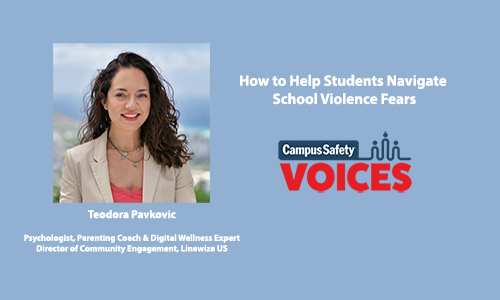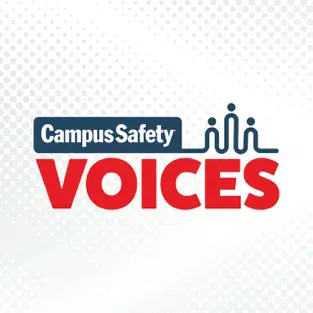Since the 1999 Columbine High School shooting, more than 311,000 U.S. students have experienced gun violence at school. While gun violence in schools is still rare, and mass shootings even rarer, there are still at least 311,000 families who have had to speak with their children or teens about gun violence and the many complicated topics that are inextricably intertwined.
Even if a family or school hasn’t been directly impacted by gun violence in schools, it is likely their children or students have questions and fears surrounding it. As adults, processing something as senseless and terrifying as a school shooting is extremely difficult and in some cases nearly impossible to fathom, so it’s understandable that children and teens might have a difficult time as well.
For students who witness school violence, it’s safe to say most of their lives have been forever changed.
“With children, in particular, safety and stability are really the two most important things that they need. They thrive in environments where there’s predictability, where there are boundaries, where they know what’s coming next. When incidents like [a school shooting] happen, they completely shatter any kind of sense that children may have had of knowing what is going to come up during the next period, what is going to come up when I go home after school, what’s going to happen tomorrow and the day after,” Teodora Pavkovic, a psychologist and parenting coach, said in an interview with Campus Safety. “They might struggle to make sense of not just the incident that happened, but life in general. Any concept of life they may have had up until that point may really be shaken. They may start to expand their fears into other areas, things that don’t really seem particularly rational or realistic.”
Children and teens who have not directly experienced school violence can also be significantly impacted.
“For kids who weren’t in the school where the tragedy happens, kids who are watching the news or hearing about it, their first questions will be around, ‘Can this happen at our school as well? That school looks kind of similar to ours. Those kids kind of look like the kids I see every single day. Could someone come and do this at our school?'” Pavkovic said.
How to Talk to Students About School Violence: A Breakdown by Age
While not all students will fall perfectly into these categories based on factors such as their emotional maturity, Pavkovic says that, dependent on age, there are different approaches that can be taken and considerations that can be made when discussing school violence (8:46).
“It’s important to keep in mind that each child will be different and each parent knows their child the best, first and foremost. Then the teachers who spend sometimes even more time with these kids than their parents do will also know best in terms of their maturity level,” she said. “These [recommendations come from] fields like psychiatry and pediatrics. Some of these recommendations give us a general sense of when to talk to kids about it, when not to, and how to do it.”
Under 10
For kids under 10, Pavkovic says it isn’t necessary to initiate conversations about school violence if the child doesn’t bring it up themselves, or if they haven’t witnessed or been exposed to conversations about it. If they do bring it up or have heard about it, it should be addressed.
“What we want to do with this age group is keep things very, very short, very minimalistic, very factual,” she says. “I think one good way to think about it is it’s sort of like a dial and you dial it down very, very low when you have very young kids.”
Ages 10-12
Pavkovic’s biggest tip for this age group is to keep them away from graphic media — both video and print — as much as possible.
“Even as adults, we really struggle to process violent imagery. It kind of sticks inside your brain and you can’t get it out,” she said. “For younger kids, in particular, this is a really big issue. They just don’t have the capacity to work through imagery like that.”
Ages 11-14
For this age group, Pavkovic says their psychological and developmental level will often need to be taken into account.
“What we often want to know is what do they already know? A lot of it will depend on that,” she said. “What have they heard already? What are some of the questions they have and what do we sense they need most from us? Do they just want us to sit with them and be quiet? Do they want us to give them a lot of reassurance in terms of being safe as a family? Do they need reassurance that school is a really safe place? Do they feel like they need to speak to a principal or a superintendent?”
Ages 15-16
For older teens, Pavkovic says a more detailed and elaborate conversation can be had, but similar to younger teens, a lot of the conversation will be led by what they’ve already heard.
“They’re definitely going to ask you some pointed, in-depth questions. They might be very angry. They might want to know how did this happen — who allowed this to happen?” she said. “It might be good to prepare a little bit in terms of how you could possibly navigate and answer some of the more complicated questions that you may not have answers to, and it’s okay to admit that as well.”
It is also common for this age group to ask questions about the person who committed the crime.
“Why did they do it? Where did this come from? What were they thinking? What were they feeling? Why did they act in this kind of way?” Pavkovic said. “Again, it’s all about that loss of any sense of control and understanding of the world. They need to make some sense of it.”
While younger children need to feel a sense of safety, security, and control, older children need this as well.
School Employees Must Emphasize Safety
While the complexity of the language and details provided varies depending on each age group, Pavkovic says the main focus for school employees should be to reiterate their safety.
“We want to emphasize the safety measures that are in place that exist right now. We want them to know exactly how these safety measures are being implemented and how this makes school a safer place for them. If we need to, we want to remind them of that on a regular basis,” she said. “We always want to end on what are we doing now and what can we do in terms of preventative measures.”
It is also important to emphasize the importance of looking out for their peers.
“This can go into conversations around what we do when we notice that someone is being bullied or what we do when we notice that a classmate is struggling in any way; if we notice that their behavior is a little bit different or they’re maybe talking about things that they don’t normally talk about — maybe their behavior has become a lot more violent or aggressive. And what do we do if we hear or see something that really worries us either way when it comes to our own safety or somebody else’s as well?” said Pavkovic. “Really communicating to kids that there are little and big things that the school is doing on a daily basis to ensure that that this is taken care of, but then also remind them of the things that they can do as well. This applies to them if they’re six or they’re sixteen — there are different things that all of these different age groups can do.”
She also recommends touching upon what was done right in response to what happened.
“We want to talk about the interventions that actually work. We want to talk about any of the positivity and support and care and help that emerged within the community in the aftermath, so they really feel that there is positive energy and people who are trying to make the very best out of it that they possibly can,” Pavkovic continued. “I think it’s also important to talk about numbers and remind them of the fact that as horrific and tragic as these events are, they are still very, very rare. They shouldn’t exist at all, but they are still very rare.”
Other topics we covered include:
- Other questions and concerns that arise among kids and teens following a violent incident at a school (3:03)
- Additional tips for school employees on how to answer questions students might have about violence (18:33)
- The importance of having all employees on the same page for how to address questions (22:06)
- Free resources to help school employees with speaking to students about violence (24:37)
- Additional advice on how parents can address the topic of school violence at home (25:47)
Watch the full interview here or listen on the go on Apple or Spotify.









